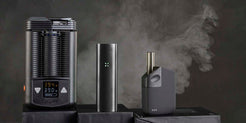The therapeutic use of Aromatic Blends dates back thousands of years and vaporization has existed since the 5th century BC, where seeds were vaporized on hot stones in Ancient Egypt. The use of an Aromatherapy Vaporizer brings the use of Aromatic Blends into the 21st century by giving the user greater control over the process versus traditional methods.
There are wide varieties of Aromatic Blends that can be enjoyed with your vaporizer. Aromatherapy Vaporization can be part of a path to help with relaxation, mood balance, better sleep, finding a creative space, cognitive function and overall physical well being. Also, simply enjoying the flavors and essences that nature has to offer is something special. It is always a good idea to consult your homeopathic practitioner or doctor before starting any new regimen.
The key to vaporizing Aromatic Blends is to make sure you are working with the right temperature range to release the beneficial compounds that you are looking for. It is also recommended to use an Aromatic Blend Grinder to ensure even and effective vaporization at the target temperature. The aromatic vapors are released through the heating process.
Here are some natural Aromatic Blends, information on their positive properties, and effective vaporization temperatures, which will hopefully help you along your Aromatherapy Vaporization path.
Our Favorite Aromatic Blends
Bearberry Leaves
Arctostaphylos Uva-Ursi
- Recommended Vaporization Temperature Range: 212°F to 302°F (100°C to 150°C)
- POTV favorite temperature: 279°F (137°C)
- Active Ingredients: tannic acid, ursolic acid, gallic acid and arbutin
- Bearberry Leaves are often an ingredient found in Kinnikinnick. They are thought to have a relaxing, calming effect. Bearberry Leaves have been used to help with headaches, constipation, bronchitis, aid in protecting the immune system, detoxify the body, speed healing, and urinary tract issues.
Blue Lotus
Nymphaea Caerulea
- aka Blue Water Lily, Sacred Lily of the Nile, Blue Egyptian Lotus
- Recommended Vaporization Temperature Range: 212°F to 257°F (100°C to 125°C)
- POTV favorite temperature: 255°F (124°C)
- Active Ingredients: nuciferine, aporphine
- Blue Lotus has be found to have a relaxing properties and restful effects. It has been used as a natural sleep aid, and to help with stress and nerves. The Nuciferine found in Blue Lotus is an antispasmodic and the Aporphine is attributed to the calming and relaxing attributes.
Calea Zacatechichi
- Recommended Vaporization Temperature Range: 365°F to 392°F (185°C to 200°C)
- POTV favorite temperature: 376°F (191°C)
- Active Ingredients: acacetin, germacranolides, caleicines, caleochromenes
- Calea Zacatechichi is a plant used in traditional homeopathy and rituals throughout its native range of Mexico and Central America. It has been used to increase intensity and memory of dreams along with treat diarrhea, dysentery, headache, stomachache, asthma and fever. It is also said to help with mental clarity.
Catnip
Nepeta Cataria
- Recommended Vaporization Temperature Range: 212°F to 302°F (100°C -150°C)
- POTV favorite temperature: 257°F (125°C)
- Active Ingredient: nepetalactone
- Catnip is universally loved by our feline roommates but happens to also have some nice uses for us homosapiens. Catnip can help with relaxation and has been used to ease headaches and coughing.
Chamomile
Matricaria Chamomilla
- Recommended Vaporization Temperature Range: 212°F to 257°F (100°C to 125°C)
- POTV favorite temperature: 246°F (119°C)
- Active Ingredients: apigenin, alpha-bisabolol
- Chamomile has anti-inflammatory properties is an antispasmodic and a relaxant. It has been used to help with anxiety and with that anxiety or stress related conditions like ulcers, colitis and indigestion. Chamomile has been known to help with getting to sleep, boost the immune system and as a treatment for both depression and headaches.
Eucalyptus
Eucalyptus Obliqua
- Recommended Vaporization Temperature Range: 257°F to 302°F (125°C to 150°C)
- POTV favorite temperature: 268°F (131°C)
- Active Ingredient: cineole
- Eucalyptus is a long used and loved aromatherapy player. It is know for it’s anti-inflammatory properties, it’s help strengthening the immune systems and contribution to regulating blood sugar. Eucalyptus has been used as a muscle relaxer and muscle and joint pain reliever. It is also helpful in relieving respiratory problems like nasal congestion, bronchitis and scintius.
Green Tea
Camellia Sinensis
- Recommended Vaporization Temperature Range: 347°F to 365°F (175°C to 185°C)
- POTV favorite temperature: 351°F (177°C)
- Active Ingredients: caffeine, various antioxidants
- Green Tea is known to be a stimulant and energizer, awaking the senses. It has been used as an anti-irritant, to relieve aches and pains, help with depression and general soothing of the body and mind.
Hops
Humulus Lupulus
- Recommended Vaporization Temperature Range: 302°F to 347°F (150°C to 175°C)
- POTV favorite temperature: 309°F (154°C)
- Active Ingredients: humulone, isohumulone, humulene, xanthohumol, isoxanthohumol, 8-prenylnaringenin
- Hops lend bitterness to those monstrous double IPAs we all love so much but they also have some nice aromatherapeutic qualities as well. Hops are said to reduce anxiety, headaches, stress and mood swings, help sexual performance, aid in reducing menstrual pain and cramping, helps reduce coughing and overall congestion, and treat insomnia and promote good sleep. Hops are known to have a mild easing effect when vaporized and lend a fantastic earthy, spicy flavor to any Aromatic Blends you might want put together.
Lavender
Lavandula Angustifolia
- Recommended Vaporization Temperature Range: 212°F to 257°F (100°C to 125°C)
- POTV favorite temperature: 255°F (124°C)
- Active Ingredients: linalool, linalyl acetate, terpinen-4-ol, camphor
- Lavender has been central in the aromatherapy world for years. It is know to help with digestion and ease insomnia and apnea. Lavender has relaxing qualities that can reduce blood pressure easing the tension on blood vessels and in turn the risk of heart disease and stroke. Stress and anxiety reduction are also key qualities of Lavender. Beside the homeopathic qualities Lavender has a lovely, signature fragrance and sweet taste that goes well with many Aromatic Blends.
Peppermint
Mentha Piperita
- Recommended Vaporization Temperature Range: 302°F to 347°F (150°C to 175°C)
- POTV favorite temperature: 329°F (165°C)
- Active Ingredients: menthol, menthone, menthyl acetate, menthofuran, 1,8-cineol
- Peppermint is another classic aromatherapy star. It has been used to help with pain relief including headaches, muscle spasm, cramps, increase immunity and eliminate nausea. Peppermint is also known to help elevate mood, stimulate brain activity and mental clarity. With these benefits and its world class flavor, peppermint is a nice touch to any Aromatic Blend.
We carry a number of aromatic blends that can be purchased here




